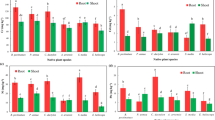Abstract
The uptake of cadmium (0.1 mg/L) into various organs of the pond snailLymnaea stagnalis L., the depuration of accumulated Cd, and the change in the natural Zn level under the influence of Cd treatment were investigated during a 2 month period. The snails were fed with lettuce (Latuca sativa). The concentrations of Cd were measured in the whole soft body, various organs (liver, viscera, foot), the shell and the lettuce; and zinc concentrations were measured in various organs and the lettuce. As its Cd concentration remained at 10 μg/g, which was much lower than the initial value for the soft body (69.4±5.71 μg/g), the shell, according to our results, is incapable of accumulating Cd. The uptake pattern of the soft body showed a correlation with the initial Cd levels depending on differences in the Cd concentration of the lettuce. At the higher initial value (69.4±5.71 μg/g) the linear Cd uptake began later then it did at the lower initial value; afterwards the snail was saturated with Cd. In the case of the lower, 9.02±1.3 μg/g initial concentration, a rapid linear Cd uptake occurred till the 7th day, then the intensity of the uptake decreased. Saturation occurred at 200 μg/g Cd concentration, regardless of the initial value. At the lower initial tissue level, the foot and the viscera showed a linear uptake pattern, while the liver, which has the greatest accumulation ability, displayed a logarithmic uptake pattern. The initial and the final Cd concentrations in the foot, viscera, and liver of theL. stagnalis were as follows: 10.3±2.15−60.1±7.13, 5.15±1.04−156±27.2, 14.1±3.09−430±23.3 μg/g respectively. The bioconcentration factors (CF) were in the 102 (foot) and 103 (viscera, liver, soft body) orders of magnitude. Forty to 45% of the accumulated Cd was depurated in Cd-free tap water; during the first three days of the uptake period, a negative linear correlation was found between Cd and Zn levels in the snail organs.
Similar content being viewed by others
References
Bluzat RL, Seuge J (1981) Effets a long terme du quatre detersifs chez le pulmoné d'eau douceLymnaea stagnalis L.: intoxication des animaux dés léclosion. Environ Pollut 25A:105–122
—, — (1983) Chronic intoxication by an herbicide 2,4,5-trichlorophenoxiacetic acid, in the pond snail,Lymnaea stagnalis. Environ Res 31:440–447
Canton JH, Slooff W (1977) The usefulness ofLymnaea stagnalis L. as a biological indicator in toxicological bioassays (model substance α HCH). Water Res 11:117–121
Coughtrey PJ, Martin MH (1977) The uptake of lead, zinc, cadmium and copper by thePulmonate mollusc,Helix aspersa Muller, and its relevance to monitoring of heavy metal contamination of the environment. Oecologia (Berl.) 73:91–98
Flegal AR, Martin JH (1977) Contamination of biological samples by ingested sediment. Mar Pollut Bull 8:90–92
Hemelraad J, Holwerda DA, Zandee DY (1986) Cadmium kinetics in freshwater clams. I. The pattern of cadmium accumulation inAndonta cygnea. Arch Environ Contam Toxicol 15:1–7
Hemelraad J, Kleinveld HA, De Roos AM, Holwerda DA, Zandee DY (1987) Cadmium kinetics in freshwater clams. III. Effects of zinc on uptake and distribution of cadmium inAnodonta cygnea. Arch Environ Contam Toxicol 16:95–101
Kaji T, Takata M, Hoshino T, Miyahara T, Kozuka H, Kurashige Y, Koizumi F (1988) Role of zinc in protection against cadmiuminduced toxicity in formation of embryonic chick bone in tissue culture. Toxicol Lett 44:219–227
Krishnamurty KV, Shpirt E, Reddy MM (1976) Trace metal extraction of soils and sediments by nitric acid-hydrogen peroxide. Atom Absorp Newslett 15:68–70
Leatherland TM, Burton JD (1974) The occurrence of some trace metals in coastal organisms with particular reference to the solent region. J Mar Biol Assoc UK 54:457–468
Meincke KF, Schaller KH (1974) Use of the snailHelix pomatia L. on cultivated land as an indicator of environmental pollution with Zn, Pb and Fe. Oecologia (Berl.) 15:393–398
Mullin JB, Riley JP (1956) The occurrence of cadmium in sea water and in marine organisms and sediments. J Mar Res 15:103–122
Phillips DJH (1980) Quantitative aquatic biological indicators. In: Mellanby K (ed) Pollution monitoring series. Applied Science Publ, London, 488 pp
Salánki J, V-Balogh K (1985) Uptake and release of mercury and cadmium in various organs of mussels. In: Salánki J (ed) Heavy metals in water organisms. Symp Biol Hung 29:325–342
—,— (1989) Physiological background for using freshwater mussels in monitoring copper and lead pollution. Hydrobiologia 188/189:445–454
Stenström T, Vahter M (1974) Cadmium and lead in Swedish commercial fertilizers. Ambio 3:91–92
Sunderman WF (1990) Cadmium substitution for zinc in fingerloop domains of gene-regulating proteins as a possible mechanism for the genotoxicity and carcinogenicity of cadmium compounds. Toxicol Environ Chemistry 27:131–141
Taylor D (1983) The significance of the accumulation of cadmium by aquatic organisms. Ecotox Environ Safety 7:33–42
V-Balogh K, Salánki J (1984) The dynamics of mercury and cadmium uptake into different organs ofAnodonta cygnea L. Water Res 18:1381–1387
V-Balogh K, Fernandez DS, Salánki J (1988) Heavy metal concentrations ofLymnaea stagnalis L. in the environs of Lake Balaton (Hungary). Water Res 22:1205–1210
Van Bruwaene R, Kirchmann R, Impens R (1984) Cadmium contamination in agriculture and zootechnology. Experientia 40:43–52
Zaroogian GE (1980)Crassostrea virginica as an indicator of cadmium pollution. Mar Biol 58:275–284
Author information
Authors and Affiliations
Rights and permissions
About this article
Cite this article
Présing, M., V.-Balogh, K. & Salánki, J. Cadmium uptake and depuration in different organs ofLymnaea stagnalis L. and the effect of cadmium on the natural zinc level. Arch. Environ. Contam. Toxicol. 24, 28–34 (1993). https://doi.org/10.1007/BF01061086
Received:
Revised:
Issue Date:
DOI: https://doi.org/10.1007/BF01061086




